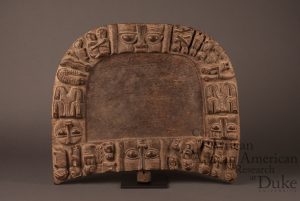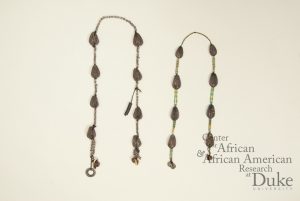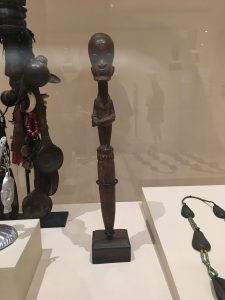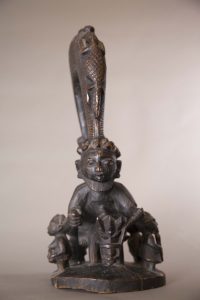Jack Bechtold
10/30/17
TAP: Religions of the Black Atlantic
Professor Brennan

I will be talking about the Cuban Santería god Eleggua and specifically an artifact of Eleggua in the Flemming museum. This artifact is the house of Eleggua. Eleggua is the Cuban god of the crossroads and of entrances. I chose Eleggua and his house because of its odd placement in the exhibit, and because of the detailed craftsmanship that caught my eye as I first saw this piece. This object is a Cuban style house ornately decorated with beautiful red and black beads these beads are arranged in a way that transforms the exterior of the house into a piece of art. These beads are arranged in patterns that add something to the house called ashe the best way it can be translated is a life force. To cap it all off the above the entryway of this house is a stone face of Eleggua that has his eyes, nose, and mouth are made from cowry shells. this house is dominated by the colors red, white, and black. These colors represent Eleggua. the way in which red, black, and white are brought into this piece is unique. this house’s structure was built with wooden walls and ceilings, this wood is painted a specific color depending on the part of the structure. the walls and ceiling of this house are painted red. the house itself sits on a dual-layered base. This base is consists of two boards that have been glued together. the top board is painted the same red as the house was. on top of being painted red, this board has a cut out in it for the dimensions of the house. the bottom board is painted entirely black. Makes the floor and shadows in the house black. The house is then outlined in cowry shells which used to be a form of currency in Nigeria and other Yoruba dominated lands, this use of shells is supposed to show wealth, status, and power. This house in itself is a shrine. It is Eleggua and it is a symbol of the crossroads themselves. The fact that this artifact is at the entryway of the museum exhibit has meaning as well. you are supposed to pray to Eleggua before you enter a house, and in the setting of an exhibit of African religions, you need to pray to Eleggua so that he may open the door to allow you to enter and see all the secrets of his world. In this essay I will provide some background on the Cuban Santería religion, then I will explain its ties to the Yoruba religion, indigenous concepts of power, and how western society demonizes that which they do not understand through Eleggua and his house.
What is Cuban santería and who is Eleggua? Cuban Santería is one of the most popular religions in the “Black Atlantic”. The religions of the Black Atlantic are the religions that came from the African slave trade. during the slave trade, many of the Africans taken to the colonized islands of South America were people of the Yoruba faith. upon getting to Cuba there were Africans from all over the western shore of the Africa itself. these people had a multitude of versions of faith. While under the constant oppression of slavery these people came up with Cuban Santería. Cuban Santeria is a religion based on indigenous power concepts. There is a multitude of different gods with different specialties. Eleggua is the god of the crossroads and entrances. he holds the ability to open and close the doorways to our destiny. worshipers need to appease Eleggua through ceremonies, songs, and rituals to make him inclined to help you. let’s say for example you need to Babalú Ayé the god of disease and epidemics because you have a child that is sick. If you do not appease Eleggua then he might not be inclined to open the doorway for communication between you and Babalú Ayé. This creates an interesting relationship between the worshiper and the gods. the worshiper has the ability to harness each god to ask for help, but if Eleggua doesn’t want to help then there is nothing to be one.
This mischievous nature has given Eleggua a bad name. In Flash of the Spirit by Robert Thompson, Mr. Thompson talks about Eshu who is the Yoruba version of Eleggua and his characterization as “ ‘The devil’ ”(Flash of the spirit page 19) by missionaries during the “enlightened times” when slavery was justified by colonialism. Thompson then continued to describe Eshu and show the reader that he isn’t “The Devil” but is “Outwardly mischievous but inwardly full of overflowing grace”(Flash of the spirit page 19). Mr. Thompson caped it off by saying that he cannot be characterized even by his own people “Even his names compound his mystery” (Flash of the spirit page 19). This is due to the fact that Eshu has many different names such as Eshu, Elegbara, Elegguá, and Elegba. He is known as “The childless wanderer” (Flash of the spirit page 19) or “owner of power”(Flash of the spirit page 19). It is incredibly interesting how Eleggua has this power that connects all of these followers with their gods and for the most part binds their society together.
Eleggua has been mischaracterized as the devil by Christians in general because of a lack of understanding on the Christians part to understand the use of indigenous concepts of power that is crucial to understanding, not just Cuban Santería, but all Afro- Atlantic religions. according to Mr. Falola and Ms. Genova and their work on Orisa Yoruba Gods and Spiritual Identity in Africa and the Diaspora. In the Yoruba religion, Eshu was one of if not the first divinities created by Olodumare who is “(The supreme being) the source, origin, and creator of all beings, including divinities,” (Page 129). If this is true then Eleggua may have had a hand in creating the world and man. considering this Eleggua cannot be the devil because he is both benevolent and malevolent, while the devil is only malevolent. If Eleggua really was the devil, antichrist, Apollyon, Beelzebub, etc. Then do you think he would have helped Olodumare create the world, the other divinities, or help all the people whose messages and prayers he does relay? It doesn’t really seem like the shoe fits. The paradox in this idea is “that can a creature be more powerful than his creator,” (Yoruba Gods and Spiritual Identity in Africa and the Diaspora page 131). Eleggua has this power given to him by Olodumare that gives him complete control over the communications sector of religious communication, which makes him so powerful that he has some sort of free will that he likes to exercise by being both benevolent and malevolent.
In Santería there are differences in the story, but the message is basically the same. according to my sources like Santería Enthroned by David H. Brown. Eleggua was created by the all-powerful God Obatala who is the “Owner of all heads” (Santería Enthroned page 126) or the owner of all destinies. In the Santería religion, you are thought to have an inner head which is your destiny. Eleggua’s job is to open the doorways to help you find your inner destiny. yet here we are again with the question can the creature be more powerful than his creator? if Eleggua is truly in control of all religious communications and he is a “trickster” then he is going to want to use his powers for benevolent and malevolent things, but that doesn’t make him the devil because he isn’t pure evil. He is as imperfect as the humans he is scribe for.
Eleggua was demonized due to a misunderstanding of indigenous conceptions of power. This could be linked to the demonization of African religions as a whole such as Haitian vodou. The key to understanding religions like these are looking at the gods and the power structure while separating your own concepts of religion.
Brown, D. (2003). Santería enthroned. Chicago (Ill.): University of Chicago Press. pp. 126
I found this book through professor Brennan. She recommended the book to me when I told her I was having trouble finding what I was looking for with the online encyclopedias. The specific passage I am interested in is on page 126. The main idea of this passage is that Elégbá or Ésú has the ability to open or close the road for your prayers, and how crucial the relationship between a believer, Ésú, and Obatalá is. Obatalá is the all-powerful God, or “owner of all heads” In santería “Head = Orí = Destiny and Ésú is the guide for destiny’s path.
Mr. Brown has an interesting perception of this relationship. He is looking at this from a very functional standpoint. If you are trying to find your destiny through your inner head then you need to have Ésú open up that road and lead you along the path to your destiny. Throughout my reading of this book Professor Brown has placed Christianity as the origin for these Afro-Cuban religions which may be his bias, but his theory on Ésú seems incredibly sound.
Mason, M. (2004). Living Santería: Rituals and Experiences in an Afro-Cuban Religion. pp.7, 95, 96.
I discovered this book in the library while looking through the books that professor Brennan had put on reserve. The pages in Living Santería: Rituals and Experiences in an Afro-Cuban Religion that I selected are talking about Elégbá or Ésú and how his ability to open the road to your destiny is not the only thing he does. in general, it means the future or he can hurt or help specific aspects of the future. Elégbá or Ésú doesn’t have to and isn’t just a tour guide to your destiny he is at the end of the day known as “the trickster”.
Mr. Mason seems incredibly similar to David Brown and even dedicates the book to him and a couple others. I believe that Mr. Mason and Mr.Brown are cut off the same branch. He is scientifically analyzing the Santería rituals and trying to pull out little pieces to later be used to build the ground on which Santería stands, but that I the reader cannot see yet. From the reading that I have done so far, I cannot see any bias in Mr. Mason’s writing.
Falola, T. and Genova, A. (2005). Orisa Yoruba Gods and Spiritual Identity in Africa and the Diaspora. 1st ed. Trenton, NJ 08607: Africa World Press, Inc., pp.129-139.
I discovered this book in the library while looking through the books that professor Brennan had put on reserve. This book was meant to show similarities and differences between Cuban Santería and Yoruba with regards to their views on Elégbá. In the section of this book that I read. Mr. Falola and Ms. Genova were arguing against all of the demonizing done to Elégbá by mainly Christian scholars. The fact that he has a power that rivals that of the all-powerful god and how his ability to be benevolent and malevolent at the same time makes him the devil.
Mr. Falola and Ms. Genova were fighting bias in this section. They were using facts to undo the demonization of Elégbá that happened when foreigners didn’t understand him or the culture he was a part of.
Thompson, Robert Farris. 1984. Flash of the Spirit. New York City, New York: vintage books.
I was introduced to this book in the Religions of the Black-Atlantic class. it is one of our main sources. This book talks about African and Afro-American art and philosophy. in the section I used specifically it talks about the Yoruba God Eshu as Mr. Thompson highlights the flaws in the argument that Eshu is the devil.
Mr.Thompson could be considered bias in the way that he is arguing against one way of thinking. I personally don’t see him being bias in his writing. I see him using facts to dismantle a bias argument.





